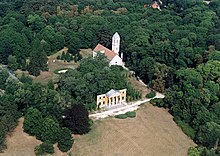Alcsút Castle
Alcsút Castle is a former royal residence in the municipality of Alcsút , in Weissenburg County , Hungary .
history
On September 20, 1795, Emperor Franz II appointed his younger brother Archduke Joseph of Austria as governor (regent) of Hungary. A year later he was elected Palatine of Hungary by the Hungarian ranks at the Reichstag in Pressburg . This made Archduke Joseph the founder of the Hungarian line of the Habsburgs.
Platin Joseph built a summer residence in the pure classicism style between 1819 and 1827 according to the plans of the well-known architect Mihály Pollack (1773–1855) . The foundation stone for this building was laid on June 13, 1820. The construction work was completed in 1826. However, it took a full year to choose the interior and to furnish the castle, which was intended as a summer residence. The family was only able to move into the castle for the first time in 1827. Archduke Joseph also had the adjacent farm buildings built and set up a model farm here.
Palatine Joseph's son, Archduke Joseph Karl Ludwig , carried out further extensive renovation and expansion work in the 1870s. He had new wings added, an inner courtyard and rebuilt the rear facade of the castle in the style of eclecticism .
At the end of the right wing of the castle were the stables built in the classicism style. When the Primate of Hungary and Archbishop of Gran János Simor paid a visit to the castle, he liked these stables so much that he explained that they would also be suitable for a chapel. Because of this suggestion, Archduke Joseph Karl Ludwig had the stables converted into a chapel. The architect Ferenc Storno was requested to carry out the renovation work . The construction work was carried out between 1879 and 1880. The new chapel in neo-Romanesque style was inaugurated on November 27, 1880 by Cardinal János Simor. Then the archive of the Hungarian Habsburgs and a library were set up at the end of the right wing in the last two large rooms.
The last reconstruction work on the castle took place at the beginning of the 20th century. At that time the courtyard was completed as a closed unit.
The house was regularly used by the family as a summer residence between 1827 and 1944. Each of the residents, beginning with Platinum Joseph and his successors, left their mark on the castle. Over the decades, the castle contained a valuable picture gallery, numerous art objects and furniture from the most varied of styles.
Archduchess Clothilde died here in 1927.
The castle and the Alcsút domain remained in the ownership of the Habsburg family until the end of the Second World War . As early as 1944 the family was forced to leave the castle. They sent the children to Germany in October 1944. The last owner of the rule, Archduke Joseph Franz and his wife, stayed the longest and only left the castle on December 19, 1944, shortly before the Red Army marched in. On December 23, 1944, the castle was occupied by the Red Army. Afterwards the castle was looted by locals and the valuable inventory was completely lost. After the occupation of Hungary by the Russians in 1945, the castle was a commander of the Red Army . During this time the castle went up in flames and burned down completely, with the valuable family archive also being burned. With the knowledge of the communist authorities at the time, the usable building material from the ruins was stolen by the residents of the area in the second half of the 1940s. In February 1951, the entire ruin , with the exception of the main facade, which is still visible today, was removed. Of the remains of the castle, only the entrance ( portico ) decorated with columns has survived today. The castle chapel is a separate building and was also badly damaged. Restoration work began only thirty years later, but it was carried out in an unprofessional and amateurish manner. Much that could have been saved was lost as a result.
The park, also laid out by Platinum Joseph in 1825 - in the style of an English garden - that surrounded the castle can still be visited today. In the park, the Palatine created an arboretum with more than 300 different rare plants. In the 1840s, the famous court gardener Emil Fuchs (born March 25, 1830 in Várpalota , † August 28, 1896 in Budapest) came to Alcsút and designed the park as it can still be seen today.
Archduke Joseph Carl Ludwig , who was science very talented, the plants of the arboretum scientifically worked on and the results he published in the book Arborethum Alcusthiense (Catalog of the planted in Alcsuter garden trees un shrubs) , which in 1892 in Cluj has appeared in print. (380 pages).
In the years 1871–1872, a 56-meter-long palm house was built - according to plans by Nikolaus Ybl - in which rare plants were stored. The park has a size of 40.5 hectares . Around 540 types of trees are cared for here.
literature
- Károly Örsi: The Alcsút Castle Park (Alcsútdoboz) . In: Die Gartenkunst 4 (1/1992), pp. 55–67.
Web links
Coordinates: 47 ° 25 ′ 24.6 ″ N , 18 ° 35 ′ 24 ″ E




